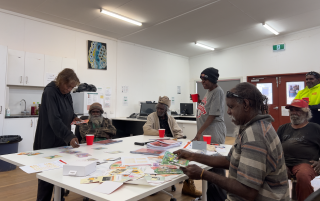From the forest floor to the foyers of grandeur, two of the finest pines growing in NSW state forests have been selected and decorated as Christmas trees at Government House and Vaucluse House in Sydney.
It’s a Christmas tradition that for years has brought festive season cheer to visitors to the iconic heritage-listed buildings.
The five-metre high radiata pines, sourced from Penrose State Forest, have been transported from the Southern Highlands to the centre of Sydney after a rigorous selection process to find perfectly shaped Christmas trees.
“These Christmas trees were carefully planted by hand five years ago and have been nurtured before being carefully selected to radiate peace and joy for the many visitors to both Government House and Vaucluse House over the festive season,” Forestry Corporation’s Moss Vale Area Supervisor, Tom Bagnell said.
Penrose State Forest has its own special Christmas story.
The plantation was first established in 1920, one of the earliest in the state.
After a fire destroyed the plantation and Penrose village in 1939, the idea of growing pine was initially discarded by the then Forestry Commission.
“However, following significant rainfall post‐fire, the pine regeneration was so significant they decided to retain the plantation, initially to sell as Christmas trees,” Mr Bagnell said.
“By the early 1950s the sale of Christmas trees to the Sydney market was a viable enterprise with some 90,000 trees being supplied by the Forestry Commission in one year alone.”
Forestry Corporation has grown pine on the site ever since with extensions to the plantation area in the 1960s and 70s.
Radiata pine (Pinus radiata) was originally named Pinus insignis or ‘remarkable pine’, an apt name for a tree, which has a host of practical uses.
This species has been grown in the local Moss Vale area for over 100 years now.
“Radiata pine is used in construction, landscaping and pulp and paper products, with NSW State forest pine plantations producing enough timber to construct a quarter of houses built in Australia each year,” Mr Bagnell said.
Although technology and mechanisation have superseded many manual tasks in forest management, Mr Bagnell said one important task in the forest remains unchanged over the past century.
“That is the planting of our pine trees. This task is still undertaken one tree at a time, manually, by keen tree planters carrying trays of pine seedlings and a shovel, planting over 1000 seedlings per person, per day,” Mr Bagnell said.
“The plantation area from where these Christmas trees were selected from will reach maturity in another 25 to 30 years where they will then contribute to supporting the sustainable natural resource requirements of future generations,” he said.
Penrose State Forest is one of many examples of state forests that are managed for a multitude of uses and values.
Contributing to a sustainable timber resource through the radiata pine plantation, the state forest is also regarded for its significant biodiversity values, renowned for Stingray Swap, which is home to a range of rare and threatened flora and fauna species.
Penrose is also a popular forest for a range of recreational activities including camping, horse riding, mountain biking, bird watching, mushroom foraging and photography and film – featuring in many television advertisements and films.






